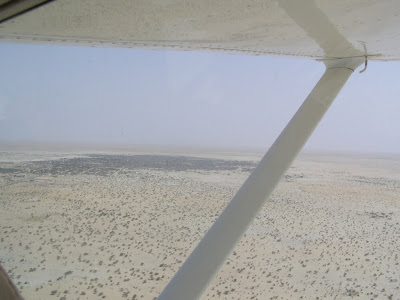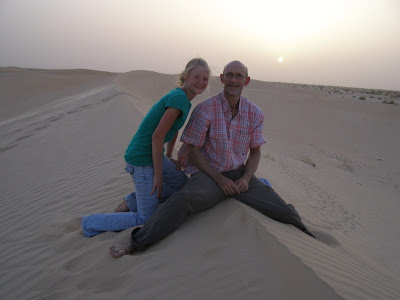 The city from the air
The city from the airFor years I’ve had a dream, a dream of visiting a city so remote and mysterious, it’s become a byword for the end of the earth, a place of isolation, a backwater of little importance. It's a "lost city" in the heart of Africa. Many people doubt it even exists. Many others have heard fantastic stories about this city, but upon seeing or hearing of it, their disappointment is palpable.
 The Djingarey Ber, or Big Mosque, which dates fron the 14th century.
The Djingarey Ber, or Big Mosque, which dates fron the 14th century.During the late Middle Ages, stories circulated throughout Europe of a city full of gold in Africa. There was also a famous library and university in the city with scholars who knew the ancient and contemporary worlds well. The library had over 700,000 manuscripts in it, some dating back as far as the 9th century. The reputation of the city spread, and Europeans wanted to find a way to get there.
By the early 1800’s, much of the world had been explored by white people, and few places remained where the foot of Europeans had not trod. Many of the “unexplored” places that remained were in Africa, and there was no place more forbidding than the Sahara, a desert bigger than all 50 US states (minus Alaska) combined.
In the early 19th century, the French Geographical Society put up a prize of 10,000 francs to the first person who could reach this city. The competition heated up between several European nations, especially Britain and France. Several explorers died trying to reach the city. The first European to do so, in 1826, was an Englishman, Alexander Gordon Laing, but he never made it back. Ultimately, it was a Frenchman, Rene Caillie, who won the prize by reaching the city in 1828 and finding his way back to Europe. This, of course, galled the British, but the contest stipulated the explorer had to make it back alive.
Rene Caillie was very disappointed by what he saw. It was no city of gold. It looked like a village perched on the edge of nowhere. He described it as a collection of mud huts on the edge of the desert. Everywhere the glaring, white hot sun pierced the stillness, and it seemed desolate and unimportant.
 The sign reads: Rene Caillie lived in this house from April to May 1828 during his voyage from Guinea to Morocco.
The sign reads: Rene Caillie lived in this house from April to May 1828 during his voyage from Guinea to Morocco.By the time Caillie reached the city, it was long past its glory days. But the stories Europeans had heard were true. Caillie had just arrived about 300 years too late to prove them. The city, which had been built on trade in things like gold, salt, slaves, and ivory, had been a wealthy city in the 14th to 16th centuries. But it had been bypassed by newer and faster trade routes, and foreign invaders (Moroccans and others) had come to the city in the late 1500’s, plundering its wealth and carrying off many manuscripts in its library.
Can you guess what city I’m talking about? Yes, it’s TIMBUKTU, and I had the privilege of making a overnight trip there on July3-4, 2008. I was able to take a tour of the city and see some of the main sites. The city is not much to look at today. Caillie’s description is still apt, but the streets are filled with history and mystery. I was able to see three of the famous mosques (one dating from the 14th century and made of mud) as well as the site of the ancient library. A new high-tech library is under construction on the site of the old one to house a collection of the old manuscripts. There are libraries all over town containing some of the ancient manuscripts that still exist. I saw places with plaques commemorating famous people I had heard and read about (among them Laing and Caillie). And there are a number of fascinating museums. The old city is a place of winding, narrow streets and ancient bazaars.

The city has a population of only about 50,000 today, well below what it once had. Still, it is the fifth holiest city in Islam and a place of pilgrimage. There are only about 200 Christians. It is located on the top of the Niger River bend about 700 miles by road upriver from Niamey, where we now live. It is still a center for trade, but today it is the tourist trade and modern merchandise that make up the majority of the commerce. Timbuktu was built on trade and the most of its inhabitants still make their living out of trade. While many of the buildings are still made of mud, many others reflect a Spanish/Moorish influence from the Moroccan invasion of 1591. These houses are constructed of a white, chalky stone similar to limestone that is mined in the desert and is more durable than mud. The wooden doors and windows are elaborate, decorated with intricate designs made of metal. The windows often have a lot of latticework.

My interest in Timbuktu is two-fold. First, there’s the history locked up in the place. Few places in the world can lay claim to as much history as Timbuktu. The second reason is Timbuktu’s connection to the Songhai. We’ve worked with the Songhai for almost 20 years, and Timbuktu was once known as a Songhai city, especially during its glory days. It was founded (or at least partially founded) by Songhai people and, until the mid-20th century, was a majority Songhai town. Today, the Songhai make up only about 25% of the population. The biggest group is the Tamasheq (also known as Tuareg), the enemies of the Songhai, who are about 60% of the population. The rest is made up of Arabs and southerners. Many tourists who go to Timbuktu buy the overpriced souvenirs that are typically Tamasheq (the same stuff we can buy in Niger), but I wasn’t interested in that.
 Suz and I on a dune in the Sahara
Suz and I on a dune in the SaharaEmbedded in the text of this blog are pictures of Timbuktu. Remember that the French spelling for the city is Tombouctou.
One final advantage of visiting the city is that now I can tell my friends I’ve been to Timbuktu.
 Welcome to Timbuktu
Welcome to Timbuktu
2 comments:
Awesome post! Thanks for all the info and photos.
John, I am so sorry about Midnight! You wrote a great blog about her--it just seems strange to know she's not there anymore. I really liked her. Do you plan to get another pet?
Congrats on getting to Tombuctu! The blog was wonderful; you surely do have the gift of writing and organizing your words. Makes me want to go, so I admit I am a little jealous (in a Christian sort of way)! ;-) I am keeping up to date with your and Nancy's blogs. Had a great talk with Sjoerd the other night. He has VOIP and it works well. Cheers for now John. You are always in our prayers!
Mike
Post a Comment